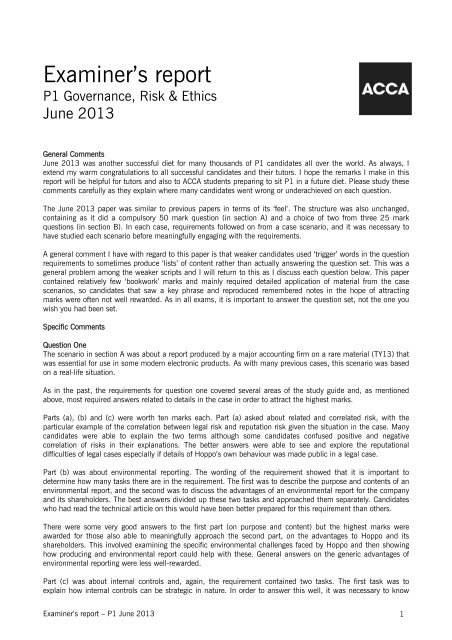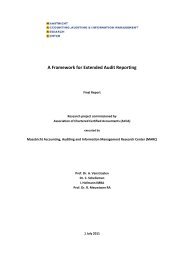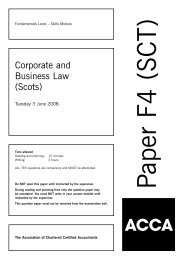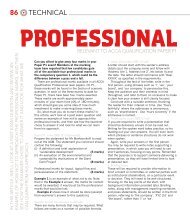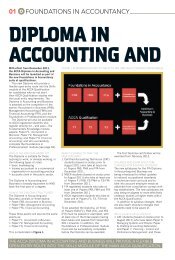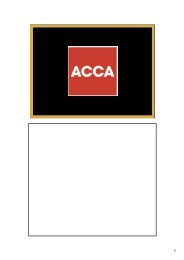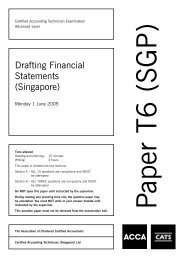P1 Examiner's Report - ACCA
P1 Examiner's Report - ACCA
P1 Examiner's Report - ACCA
Create successful ePaper yourself
Turn your PDF publications into a flip-book with our unique Google optimized e-Paper software.
Examiner’s report<br />
<strong>P1</strong> Governance, Risk & Ethics<br />
June 2013<br />
General Comments<br />
June 2013 was another successful diet for many thousands of <strong>P1</strong> candidates all over the world. As always, I<br />
extend my warm congratulations to all successful candidates and their tutors. I hope the remarks I make in this<br />
report will be helpful for tutors and also to <strong>ACCA</strong> students preparing to sit <strong>P1</strong> in a future diet. Please study these<br />
comments carefully as they explain where many candidates went wrong or underachieved on each question.<br />
The June 2013 paper was similar to previous papers in terms of its ‘feel’. The structure was also unchanged,<br />
containing as it did a compulsory 50 mark question (in section A) and a choice of two from three 25 mark<br />
questions (in section B). In each case, requirements followed on from a case scenario, and it was necessary to<br />
have studied each scenario before meaningfully engaging with the requirements.<br />
A general comment I have with regard to this paper is that weaker candidates used ‘trigger’ words in the question<br />
requirements to sometimes produce ‘lists’ of content rather than actually answering the question set. This was a<br />
general problem among the weaker scripts and I will return to this as I discuss each question below. This paper<br />
contained relatively few ‘bookwork’ marks and mainly required detailed application of material from the case<br />
scenarios, so candidates that saw a key phrase and reproduced remembered notes in the hope of attracting<br />
marks were often not well rewarded. As in all exams, it is important to answer the question set, not the one you<br />
wish you had been set.<br />
Specific Comments<br />
Question One<br />
The scenario in section A was about a report produced by a major accounting firm on a rare material (TY13) that<br />
was essential for use in some modern electronic products. As with many previous cases, this scenario was based<br />
on a real-life situation.<br />
As in the past, the requirements for question one covered several areas of the study guide and, as mentioned<br />
above, most required answers related to details in the case in order to attract the highest marks.<br />
Parts (a), (b) and (c) were worth ten marks each. Part (a) asked about related and correlated risk, with the<br />
particular example of the correlation between legal risk and reputation risk given the situation in the case. Many<br />
candidates were able to explain the two terms although some candidates confused positive and negative<br />
correlation of risks in their explanations. The better answers were able to see and explore the reputational<br />
difficulties of legal cases especially if details of Hoppo’s own behaviour was made public in a legal case.<br />
Part (b) was about environmental reporting. The wording of the requirement showed that it is important to<br />
determine how many tasks there are in the requirement. The first was to describe the purpose and contents of an<br />
environmental report, and the second was to discuss the advantages of an environmental report for the company<br />
and its shareholders. The best answers divided up these two tasks and approached them separately. Candidates<br />
who had read the technical article on this would have been better prepared for this requirement than others.<br />
There were some very good answers to the first part (on purpose and content) but the highest marks were<br />
awarded for those also able to meaningfully approach the second part, on the advantages to Hoppo and its<br />
shareholders. This involved examining the specific environmental challenges faced by Hoppo and then showing<br />
how producing and environmental report could help with these. General answers on the generic advantages of<br />
environmental reporting were less well-rewarded.<br />
Part (c) was about internal controls and, again, the requirement contained two tasks. The first task was to<br />
explain how internal controls can be strategic in nature. In order to answer this well, it was necessary to know<br />
Examiner’s report – <strong>P1</strong> June 2013 1
what ‘strategic’ meant and this is usually contrasted with the operational. Each level has its own objectives,<br />
activities, timescales and areas of responsibility. In addition though, risks can also be strategic or operational in<br />
nature, and the internal controls at the two levels are also different. Many candidates had a good idea about this<br />
and were able to gain at least one of the two marks available, with many achieving both marks.<br />
The more ambitious task in part (c) was to ‘explain, using detailed examples from the case, why developing<br />
sound internal controls over the supply and processing of TY13 would be important if Hoppo opted to build its<br />
own factory in Yuland’. This obviously necessitated a detailed analysis of the case in order to gather the reasons<br />
why such internal controls would be necessary. The case mentioned a number of features about TY13 that meant<br />
that sound controls would be necessary were Hoppo to process it in its Yuland factory. These included its high<br />
cost, its toxicity, the general supply problems and the variable quality of the raw material. All of these would be<br />
essential in any processing facility. It is clear from this example that it would not be possible to gain marks in this<br />
task without a detailed examination of the case.<br />
The professional marks in part (d) were for presenting the answers in the form of a press release. As with<br />
previous exams, there was a full range of attempts with varying degrees of success in framing the answers in the<br />
requested manner. Many made a good attempt, gaining three or four of the professional marks, whilst others<br />
made no obvious attempt at all. It was frustrating to see some candidates setting out their answer as a memo or<br />
a letter when this was clearly not what was being asked in the requirement. It was also important to present the<br />
answer as a press release and not just as an exam answer. In a press release, for example, it would be unusual<br />
to see terms like deontological or consequentialist in part (d)(ii). The model answers present the contents of these<br />
two positions but do not use the actual terms except as a commentary.<br />
The content of the press release was intended to address concerns over the request for a bribe by the mayor of<br />
Ootown. For six marks in part (d)(i), candidates were required to define and explain integrity and transparency in<br />
the context of the case. The marking scheme allowed three marks for each but answering it ‘in the context of<br />
case’, i.e. relating to Hoppo’s situation, was important to get full marks. A common approach was to define the<br />
two terms (essentially bookwork) but then fail to adequately develop the connection to the case. It was<br />
disappointing to see this because it didn’t take very much extra analysis to attract the extra ‘case related’ or<br />
applied marks.<br />
There was a wide range of answers to part (d)(ii). The requirement examined the content on bribery in the <strong>P1</strong><br />
study guide and asked candidates to construct the argument against paying the bribe to the mayor of Ootown.<br />
The requirement asked that this argument should include both business and ethical perspectives against paying<br />
the bribe. For ten marks, candidates should have been alerted to the need for a fairly detailed consideration of<br />
these issues. A typical poor answer briefly discussed the essential features of both deontological and<br />
consequentialist ethical approaches, but did not then adequately relate these to the case. This requirement was<br />
done poorly on average. Perhaps the verb ‘construct’ was difficult for some candidates but in addition, the<br />
business case for not paying the bribe was often poorly developed.<br />
Question Two<br />
The themes examined in question 2 were the importance of internal audit, audit committees, the internal audit<br />
function and the role of internal audit in providing assurance in the integrity of financial reporting. Overall, it was<br />
disappointing to sometimes see candidates resorting to memorised ‘lists’ rather than answering the questions set.<br />
In part (a), for example, the question was not asking about the importance of internal audit per se, but rather to<br />
consider the importance of internal audit in responding to regulation in highly regulated industries (such as water<br />
in the case). This task required candidates to consider the roles of internal audit in a specific industry situation.<br />
Higher scores were awarded to those able to do this more successfully and this, again, underlines the importance<br />
of answering the question actually set rather than the one that candidates wish had been set.<br />
Examiner’s report – <strong>P1</strong> June 2013 2
There were two requirements in 2(b) with both carrying equal marks (6 marks each). The first was to criticise the<br />
audit committee’s performance in the case. This involved knowledge of best practice so as to assess how the<br />
audit committee has failed against that, and also, of course, a thorough reading of the case. Again, the question<br />
was not asking about the roles of an audit committee, and weaker answers wrote in general terms rather than<br />
analysing the content of the case.<br />
The second task was to explain one particular aspect of an audit committee’s work with regard to its oversight of<br />
the internal audit function. There is a difference between an audit committee and the internal audit function: the<br />
committee is a board level committee and the internal audit function is a department in an organisation<br />
responsible for monitoring compliance and other important internal audit outcomes. In many organisations, the<br />
internal audit function reports its findings to the audit committee and the question was asking why this<br />
arrangement is chosen in most cases. This means, ‘why is the audit committee a suitable body to perform this<br />
function?’. Weaker answers, perhaps on seeing the words, ‘internal audit function’ produced a list of the purposes<br />
or functions of internal audit from COSO or similar. This was not the correct approach, and better answers<br />
considered the relationship in terms of internal audit helping to achieve the strategic aims of the company,<br />
remaining independent of those being audited, operating with the necessary board-level authority and meeting<br />
the compliance needs of the company as determined by the non-executive directors on the audit committee.<br />
Part (c) was on the use of internal controls in assuring the integrity of financial reporting. It was disappointing to<br />
see this being poorly answered by many candidates, especially when the subject matter of the requirement was<br />
so important in corporate governance. It was a lack of confidence in financial reporting that led to the rise of<br />
corporate governance regulation in many countries of the world. It was the restatement of the financial reports of<br />
Enron in 2001/2 that was the first signal that its corporate governance systems were ineffective, and so the<br />
assumption that financial statements are true and fair is a very important assumption for investors to make.<br />
Strong internal controls are necessary to underpin this integrity of reporting. The most common answer to this<br />
was a brief discussion of the general importance of internal controls and this was clearly not what the question<br />
was asking.<br />
Question Three<br />
The case in question 3 was about a reduction in bank lending in Dubland, with one bank in particular, BigBank,<br />
being the subject of discussion. The requirements were about risk assessment, fiduciary duties and financial risk.<br />
Part (a) began by asking candidates to explain the meaning of ‘risk assessment’. This was a relatively<br />
straightforward requirement for many (with regard to the impacts and probability of identified risks). Weaker<br />
answers discussed the whole risk auditing process: identification, assessment, management, reporting, but this<br />
was not necessary. The question was only about risk assessment.<br />
The second task in part (a) was to examine the case and to use that analysis to explain why risk assessment<br />
need to be ‘continuous and ongoing’. Weaker answers forgot to attempt this task at all after discussing risk<br />
assessment but better answers showed how frequent and unpredictable environmental changes create changes to<br />
an organisation’s risk profile.<br />
Part (b) touched on the stakeholder/shareholder debate and asked candidates to critically evaluate a remark<br />
made by Mr Ng in the case. His remark that his ‘only duty’ was to the shareholders, was a ‘pristine capitalist’<br />
type remark and the critical evaluation involved a consideration of both sides of the argument. Candidates who<br />
were able to see what this question was asking (the stakeholder/shareholder debate) often achieved good marks<br />
but weaker answers attempted to define ‘fiduciary duty’ but offered little discussion beyond that.<br />
Part (c) was about embedding financial risks in large organisations using BigBank as an example. The<br />
requirement contained two tasks: to explain financial risk and then to discuss how financial risks can be<br />
embedded in BigBank. Weaker answers made an attempt to explain financial risk but then failed to develop the<br />
Examiner’s report – <strong>P1</strong> June 2013 3
second task on embedding risk. Stronger answers were able to place the idea of embedding risk into the context<br />
of the case and with regard to BigBank’s situation in particular.<br />
Question Four<br />
This question was about Boom Co and the deliberations of its remuneration committee in meeting to agree the<br />
rewards of its executive directors. In the committee’s discussions, its chairman, Sarah Umm, read out the<br />
relevant part of the corporate governance code on the subject (this was drawn from a real code of corporate<br />
governance). The requirements were on the purposes of corporate governance codes, how reward packages can<br />
be balanced to achieve a particular outcome (in this case, to incentivise medium to long-term growth) and finally<br />
on the roles of non-executive directors.<br />
Many candidates performed poorly on parts (a) and (c) and in most cases, this was due to a failure to develop<br />
answers to the second task in each requirement. The first task in part (a) asked for an explanation of a code of<br />
corporate governance and whilst most candidates were able to offer a fair answer to this, a minority seemed to be<br />
confused over the word ‘code’, and instead offered a definition of corporate governance itself. The second task in<br />
part (a) was about the general purposes of a CG code for listed companies such as Boom Co and I was surprised<br />
that many answers failed to address this very well, especially as it was substantially bookwork and could have<br />
been answered by a well-prepared candidate.<br />
A frustration with part (b) was candidates, seeing the term ‘components of a reward package’, automatically<br />
reproduced the list of such components (basic pay, performance bonuses, etc.). This was not what the question<br />
was asking for. The requirement specifically asked about incentivising medium to long term growth whilst<br />
retaining the existing board in place. So candidates needed to think about how these components could be<br />
blended and offered to achieve these outcomes. There were no marks for a list of the components of a reward<br />
package on its own.<br />
Part (c) contained two tasks. The first was a relatively straightforward task about the general roles of nonexecutive<br />
directors. Most candidates were able to make a reasonable attempt at this (strategy, scrutiny, people,<br />
risk) and were able to attract four of the ten marks available. The second task was poorly done overall, requiring<br />
candidates to discuss a specific restriction on the rewards of non-executives. The importance on a non-executive’s<br />
independence and his or ability to provide scrutiny on behalf of the shareholders is the key to understanding this.<br />
Some otherwise weak answers were able to discuss non-executive independence and were of course rewarded for<br />
that.<br />
Examiner’s report – <strong>P1</strong> June 2013 4


